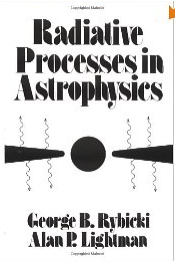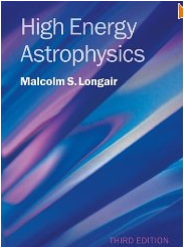Laboratory |
|
русский / english
|
Education and Outreach |
||||||||||||||||||||||||||||||||||||||||||||||||||||
Course: Gamma- and X-ray AstrophysicsINSTRUCTOR: Professor George F. Smoot
| ||||||||||||||||||||||||||||||||||||||||||||||||||||
 |
Radiative Processes in Astrophysics – [George B. Rybicki, Alan P. Lightman] - Rybicki & Lightman John Wiley & Sons, 1979 - Pages: 382
Radiative Processes in Astrophysics: This clear, straightforward, and fundamental introduction is designed to present-from a physicist's point of view-radiation processes and their applications to astrophysical phenomena and space science. It covers such topics as radiative transfer theory, relativistic covariance and kinematics, bremsstrahlung radiation, synchrotron radiation, Compton scattering, some plasma effects, and radiative transitions in atoms. Discussion begins with first principles, physically motivating and deriving all results rather than merely presenting finished formulae. However, a reasonably good physics background (introductory quantum mechanics, intermediate electromagnetic theory, special relativity, and some statistical mechanics) is required. Much of this prerequisite material is provided by brief reviews, making the book a self-contained reference for workers in the field as well as the ideal text for senior or first-year graduate students of astronomy, astrophysics, and related physics courses. Radiative Processes in Astrophysics also contains about 75 problems, with solutions, illustrating applications of the material and methods for calculating results. This important and integral section emphasizes physical intuition by presenting important results that are used throughout the main text; it is here that most of the practical astrophysical applications become apparent. |
 |
High Energy Astrophysics — (third edition) 2011. Longair, M.S. Cambridge: Cambri dge University Press - Pages: 888 Providing students with an in-depth account of the astrophysics of high-energy phenomena in the Universe, the third edition of this well-established textbook is ideal for advanced undergraduate and beginning graduate courses in high energy astrophysics. Building on the concepts and techniques taught in standard undergraduate courses, this textbook provides the astronomical and astrophysical background for students to explore more advanced topics. Special emphasis is given to the underlying physical principles of high-energy astrophysics, helping students understand the essential physics. Now consolidated into a single-volume treatment, the third edition has been completely rewritten. It covers the most recent discoveries in areas such as gamma-ray bursts, ultra-high energy cosmic rays and ultra-high energy gamma-rays. The topics have been rearranged and streamlined to make them more applicable to a wide range of different astrophysical problems. |
 |
Additional Advanced Reference for basic electromagnetism: Classical Electrodynamics Third Edition by John David Jackson The defining book covering the physics and classical mathematics necessary to understand electromagnetic fields. |
F. PREREQUISITES
The student is expected to have completed a standard undergraduate physics curriculum and understand basic electromagnetism and Special Relativity well and a bit of quantum mechanics and so forth. The book Classical Electrodynamics by J.D. Jackson has a very good and strong course covering all the basic and advanced material needed for the course.
G. GRADING PLAN
Coursework will be weighted as follows:| 1. | Homework | 25% | ||||||
| 2. | Quizzes | 25% | ||||||
| 3. | Final exam | 30% | ||||||
| 4. | Attendance & Participation |
___ |
___ |
20% |
||||
| 25% | + | 55% | + | 20% | = | 100% |


